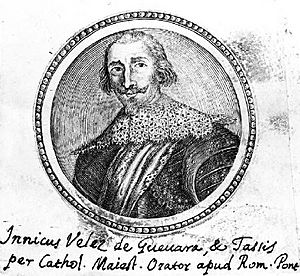Íñigo Vélez de Guevara, Count consort of Oñate facts for kids
Íñigo Vélez de Guevara (born in 1566 in Salinillas de Buradón, Alava; died on October 31, 1644, in Madrid) was an important Spanish political figure. He was known as the Count of Oñate and the Count of Villamediana. He played a big role in the Thirty Years' War, a major conflict in Europe.
Contents
Early Life and Titles
Íñigo Vélez de Guevara was the son of Pedro Vélez de Guevara and María de Tassis. He married Catalina Vélez, who was the 5th Countess of Oñate. When Catalina's only brother, Ladrón, died in a sea battle against the English in 1588, Catalina became the Countess of Oñate. This meant Íñigo became the Count consort of Oñate through his marriage.
Later, after his cousin Juan de Tassis y Peralta died, Íñigo also received the title of Count of Villamediana.
A Diplomat for Spain
Íñigo Vélez de Guevara served as Spain's ambassador to the Holy See. An ambassador is like a country's representative in another country or organization. His job was to represent Spain's interests and communicate with the Pope and other leaders in the Vatican.
Role in the Thirty Years' War
The Thirty Years' War was a long and complex conflict in Europe (1618-1648). It involved many countries and was partly about religion (Protestants versus Catholics) and partly about power.
As Spain's ambassador in Vienna, Íñigo played a key part in the war. He helped convince Saxony, a Protestant region, to join forces with the Emperor against Bohemia. In return, Saxony would gain control over a region called Lusatia.
The Saxons then invaded Bohemia. Meanwhile, a Spanish army from Brussels, led by Ambrosio Spinola, helped the Emperor. This army stopped other Protestant forces from helping Bohemia.
The Battle of White Mountain
Íñigo also worked to transfer the title of Elector of the Palatinate to the Duke of Bavaria. This was done to get the Duke's support and the help of the Catholic League.
The Catholic League army, led by General Tilly, helped bring peace to parts of Austria. The Emperor's forces also helped. Together, these armies moved into Bohemia.
On November 8, 1620, the Emperor's forces, led by Ferdinand II, won a major victory against Frederick V at the Battle of White Mountain. This battle took place near Prague. This victory meant Bohemia remained under the control of the Habsburg family for a very long time and became Catholic.
Later Life
After his work in the war, Íñigo had hopes of becoming a very important advisor to the King of Spain, similar to the Duke of Lerma. However, the King chose someone else, the Count-Duke of Olivares, who was Íñigo's rival. Because of this, Íñigo lost the King's favor. Later, Luis de Haro became the successor to Olivares.
Family
Íñigo Vélez de Guevara had several children:
- Pedro, who became the 6th Count of Oñate, but sadly died after falling off his horse in Milan.
- Juan, who became the 7th Count of Oñate and was a priest.
- Íñigo, who became the 8th Count of Oñate (1597–1658) and served as the Viceroy of Naples.
- Felipe Emmanuel, who died in battle near Perpignan in 1642.
- Beltrán, who became the Viceroy of Sardinia.
- María Ana, who married Don Antonio María.
- Maria Angela, who became a nun.
- Catalina, who became a nun.
- Ana Maria, who became a nun.
See also
 In Spanish: Íñigo Vélez de Guevara y Tassis para niños
In Spanish: Íñigo Vélez de Guevara y Tassis para niños


